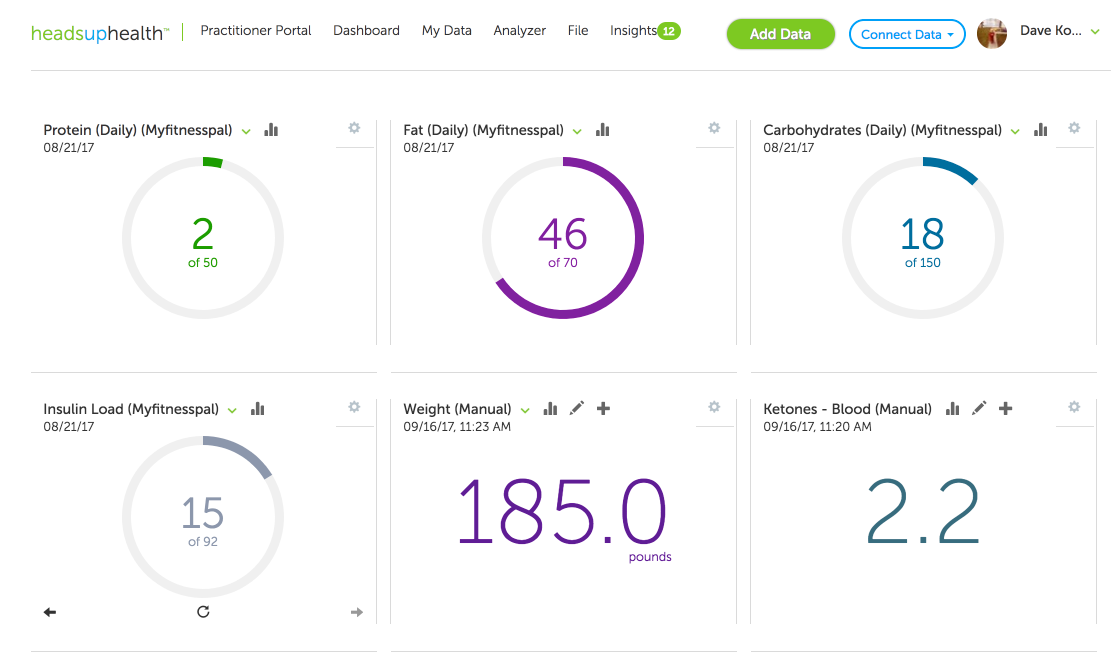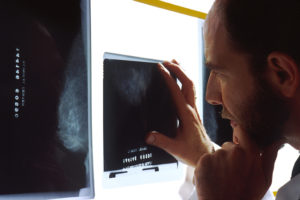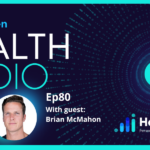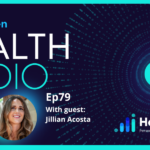
by Heads Up Health | Sep 17, 2017 | Self Tracking
Tracking basal body temperature can be a useful tool that can help you to uncover hypothyroid and even hyperthyroid patterns, just by taking your temperature at the same time every morning for five consecutive days.
Heads Up Health makes it easy to track, trend and compare your basal body temperature readings alongside all your other health metrics. Start your free 30-day trial using the button below. Or, read on to learn more about basal body temperature and how to track it.
[maxbutton id=”5″]
Basal Body Temperature
 When tracking basal body temperature, we want to track your resting temperature which is a reflection of your metabolic activity with minimal influence from outside factors like digestion, exercise, stress, etc. After you’ve been asleep for several hours, the body has ideally settled into its resting metabolic pattern, so we have a way to compare your temperature with as little interference as possible.
When tracking basal body temperature, we want to track your resting temperature which is a reflection of your metabolic activity with minimal influence from outside factors like digestion, exercise, stress, etc. After you’ve been asleep for several hours, the body has ideally settled into its resting metabolic pattern, so we have a way to compare your temperature with as little interference as possible.
Thyroid Symptoms
Most everyone knows someone with a thyroid condition. Maybe you even suspect that you have a thyroid condition, but haven’t made an appointment with your doctor yet or your labs have all come back normal. If you suspect that you may have a thyroid condition, these are some of the symptoms that you may be experiencing.
Hypothyroid Symptoms (more common)
- low body temperature-feeling cold in a warm room, or having cold hands and feet consistently.
- apathy or depression
- lack of motivation
- fatigue
- constipation
- inability to lose weight or weight gain
- frequent colds
- swelling in ankles
- lack of libido
- hair loss
- insomnia and more.
Hyperthyroid Symptoms (less common)
- increased heart rate
- anxiety
- insomnia
- frequent and loose bowel movements
- sweating
- unintended weight loss and more.
Hypothyroidism is so prevalent that its become a thing we just expect to have happen to us at some point, and we often accept that these symptoms are just a consequence of getting older. Symptoms are messengers from our body, alerting us to a system that is out of balance. The thyroid influences almost every cell in the body, so when it’s not supported, the symptoms can present in other areas of our bodies. Using the basal body temperature readings developed by Dr. Barnes can help you to hone in on a potential thyroid condition and allow you to seek the help you need to support your thyroid.

The basal body temperature test can be used whether or not you’ve had a thyroid test recently. Thyroid hormones are made in the thyroid, but most of the active (energy) thyroid hormone T3 is converted from the inactive (storage) T4 form in other parts of the body, which means that thyroid function is about more than just the TSH hormone levels in the blood. Other sites of conversion include the gut (20%), liver (40%) and peripheral tissues (20%). A compromise in the liver or gut can cause a decrease in the conversion of the inactive thyroid hormones to the active thyroid hormones. Another factor to consider is vitamin and mineral deficiencies as the thyroid uses iodine, selenium, zinc, magnesium, the amino acid Tyrosine, as well as vitamins A, C, D, B2, B3, B12 and healthy fats to function optimally.
Because your gut health is a major site of thyroid conversion, Tracking your Bristol Stool Chart can be another piece to the puzzle when trying to figure out a thyroid pattern. Thyroid dysfunction can alter bowel movement patterns as well, which can clue us in to the possibility of a thyroid issue.
The body can compensate for quite a while on reduced resources before the blood will show a significant change to be diagnosed with a thyroid disorder. Tracking your basal body temperature for 5 days can give you a better understanding of a trend for either hypo or hyper thyroid patterns, so you can further explore paces where the breakdown may be happening. Hypothyroid is much more common than hyperthyroid, but either can occur. For more info on what labs are important to ask for when you talk to your doc, check out Amy Berger’s article on Thyroid testing here. Though she talks about it in the context of a low carb diet, the testing info will apply to anyone who thinks they may need a thyroid panel worked up.
HOW to take your Basal Body Temperature for tracking.

Prepare the night before you want to start tracking you basal body temperature. You’ll need a thermometer (glass is preferred as it’s more accurate than digital for this purpose-avoid mercury and opt for a Geratherm glass thermometer which you can find here), your phone/device for timing and documenting your results.
*Note – if you sleep with a heated blanket, or multiple heavy blankets, you’ll want to remove them for the nights that you’ll be collecting your data, to get an accurate reflection of your body temp.
- Shake down your thermometer so that it’s ready for morning. Place all supplies by the bed where you can reach them with minimal effort in the morning.
- When you awaken, you will take your thermometer and place it in your armpit for minimum of 5 min (glass will need at least 4 min for accuracy), first thing in the morning. Try to move minimally so as to not rev up your body temp. After 5-10 min, record your temperature and go about your day as normal.
- Repeat this process for 5 consecutive days.
- Ladies, you will want to avoid starting or collecting data on day 19-22 of your menstrual cycle as there are fluctuations due to other hormones as well as related to ovulation, which we will talk about in a subsequent basal temperature tracking article.

How to interpret your readings.
Dr. Barnes found that a normal resting body temp should be between 97.8-98.2 degrees Fahrenheit. If it is consistently lower, then there is a trend toward a hypothyroid (decreased function) pattern. If consistently above 98.2, then this indicates a trend for more of a hyperthyroid (increased function) presentation. If results are mixed, both high and low, this is often more indicative of a primary adrenal stress pattern, as the adrenals and thyroid are closely linked, which would allow for the variation in body temperature.

What to do with your results
If you find that your temperatures indicate the possibility of thyroid or adrenal stress, take your readings in your Heads Up Health app to your functional health doctor/provider so you can further investigate where the breakdown could be and support for healing.
[maxbutton id=”5″]
Disclaimer- The content in this post is not intended to be a substitute for professional medical advice, diagnosis, or treatment. Always seek the advice of your physician or other qualified health provider with any questions you may have regarding a medical condition. Never disregard professional medical advice or delay in seeking it because of something you have read in this post.

by Heads Up Health | Sep 16, 2017 | Self Tracking
The Feldman protocol…picture this scenario….
You’ve been following a low carb or ketogenic diet. You’ve lost weight, your acid reflux is gone, your blood pressure’s normal for the first time in years, your blood sugar’s better, you’ve been able to ditch some of your type 2 diabetes meds, you have more energy, and your joints no longer feel like you need to spray them with WD-40. You feel like a new person! Your doctor is thrilled with all this … until your cholesterol results come back. (more…)

by Dave Korsunsky | Jul 25, 2017 | Self Tracking
Heads Up Health allows you to track the Bristol Stool Chart to help you identify problematic foods, supplements, digestive health and other lifestyle stressors. While it may seem foreign or unusual to examine what comes out of your body, it’s pretty important for improving or maintaining your health. The amount of time your food travels through your body can give you clues as to whether or not the fuel you’re putting into it is best serving you and if you’re able to digest and assimilate it well. (more…)

by Heads Up Health | Jun 6, 2017 | Self Tracking
Thyroid function is a hotly debated topic in the low-carb world. While most people typically experience fat loss, better energy levels, and improved overall vitality on a low-carb diet, in some individuals, measurements of thyroid-related hormones suggest that a low carbohydrate intake might be having adverse effects on the thyroid gland. Is it possible that a way of eating that has such wonderful benefits for so much of the body could be harmful to the thyroid?
This is the fifth installment of a series exploring lab tests for people following low-carb diets. Due to the effects of the low-carb or ketogenic ways of eating on overall metabolism, interpreting certain lab tests requires a slightly different perspective compared to results from people following high-carb diets.
Previous posts have explored blood glucose testing, fasting insulin, and HOMA-IR (and remember: if you’d like to get some tests your doctor isn’t familiar with, or to test more frequently than your insurance will cover, this recent Heads Up Health post will show you how to order your own lab tests).
Keeping track of your numbers is an important step for anyone who wants to transform their health. Heads Up Health was created to empower you to manage all of your health data, including your lab test results, in one secure location. You can learn more on our homepage or by clicking below to create your account and start building your own centralized health portfolio.
[maxbutton id=”6″]
(more…)

by Heads Up Health | Jun 5, 2017 | Self Tracking
We’ve covered a lot in our low-carb lab testing series so far. At this point, we felt it was time for a real-world case study to tie everything together. In this post we will take a look at my own experience ordering fasting glucose and fasting insulin tests, calculating my HOMA-IR score, and tracking results in my Heads Up profile.
Heads Up Health is a web-based product designed to help individuals centrally manage their health data. By giving you powerful tools for self-directed and data-driven care, our product can be your compass on the path to optimal health. You can learn more or create your account by clicking the button below. Or, read on for our case study on Low-carb Lab Testing.
[maxbutton id=”6″]
Low-carb lab testing – a case study
As we’ve explored in previous posts, there are many reasons why an individual may see normal blood glucose levels and still be at risk for metabolic issues down the road. One possible reason is that the body is over-compensating with insulin to keep blood sugar within normal ranges. I decided to put this to the test with my own data.
Yes, I regularly check my fasting blood glucose levels at home as part of my low-carb/ketogenic lifestyle. And yes, according to my glucometer, my blood sugar is within healthy ranges. But as we know, relying on just my glucometer (without a corresponding fasting insulin test), doesn’t always tell the full story. I felt it was an ideal opportunity for some self-directed n=1 experimentation. I was curious to see the fasting insulin data and calculate my own HOMA-IR score.
Step 1 – Ordering the tests
Unfortunately, many conventional doctors within the US will not order a fasting insulin test unless they suspect metabolic disease (or you have already been diagnosed with a metabolic disease). This doesn’t do much good for the person who is trying to be proactive. Even if you do successfully sweet-talk your doctor into ordering the tests you want, there are no guarantees your insurance company will cover the cost of the test. Fighting with an insurance company over tests they won’t cover is enough to make a grown man (or woman) cry. I’ve been on the losing end of many such battles and it’s a miserable place to be.
To bypass uncooperative doctors and insurance companies, I personally use request-a-test.com to order my own labs. Request-a-test allows you to choose between LabCorp or Quest Diagnostics for the blood draw. Heads Up Health can electronically connect to Quest Diagnostics so my results will update automatically.
I purchased the fasting insulin test for $49 and the fasting glucose test for $29. The overall cost was not much more than my insurance co-pay if I were to see a doctor.

Ordering your own glucose and insulin tests
Step 2 – Scheduling the blood draw
I scheduled an appointment with Quest Diagnostics to have the blood draw.
Note: for extra nerd points, I brought my glucometer with me to the lab. I wanted to take a reading with my glucometer at the same time as the laboratory blood draw so I could see how accurate my glucometer was compared to results from a full-blown lab testing company with far more sophisticated technology for analyzing blood samples. Results are covered later in this post.

To check the accuracy of my glucometer, I took a reading at the same time as my lab draw from Quest.
Step 3 – Assessing my test results
Within 24-hours, I received an e-mail notification from request-a-test that my test results were available. Since it had been many years since my last fasting insulin test, I was anxious to see the results:
- Fasting glucose: 84 mg/dL
- Fasting insulin: 4.8 µIU/mL
Note: The reading on my glucometer was 88 mg/dL (compared to 84 mg/dL from Quest), which was taken just moments before the blood draw from the lab. Overall, I’d say my trusty old glucometer held up pretty well!
Step 4 – Calculating my HOMA-IR score
With fasting insulin and fasting glucose readings in hand, I was now equipped with the data I needed to calculate my HOMA-IR score to assess my level of insulin resistance.
I used the HOMA-IR calculator located here. After entering my results into the HOMA calculator, my score was 1.0. I was pleased with this result and felt assured that both glucose AND insulin levels were properly in check.

Calculating my HOMA-IR score
Step 5 – Tracking my results
Heads Up Health was designed to empower individuals to make informed, data-driven health decisions. Our product gives you the ability to easily track and manage your own lab test results, which can be a powerful tool on your own health journey.
I entered my results for fasting glucose, fasting insulin, and HOMA-IR and saved this data in my Heads Up profile. I also uploaded a copy of the PDF from the lab so I have the source documents for future reference.

Tracking your results with Heads Up
Summary
This post is a simple example that summarizes the topics covered thus far in the Low-carb Lab Testing series. The post demonstrates how anyone can get in the driver’s seat and order their own labs when the need arises.
I was able to order my own fasting glucose and fasting insulin tests without the need for doctor intervention. I was then able to calculate my HOMA-IR score and assess my results. Lastly, I used Heads Up Health to store my results so I have easy access to them for future reference. I can also test again in a year or two and easily compare my results to previous tests.
This is true patient empowerment and something everyone should have access to if they so desire.
[maxbutton id=”7″]

by Dave Korsunsky | May 29, 2017 | Self Tracking
Breast cancer occurs when the normal cells in the breast start growing rapidly and spreading locally. If left untreated, these cells can travel to other parts of the body and continue to grow. Besides skin cancer, breast cancer is the most common type of cancer and it is the second leading cause of cancer-related deaths in US women (lung cancer is the first). Preventing breast cancer is not possible in most cases, but thanks to a few simple breast cancer screening tests, we can detect breast cancer in its initial stages, when treatment is more successful.

How do we Screen for Breast Cancer?
You may hear about other ways to screen for breast cancer, but for average-risk women, screening mammography is the gold standard of care.
Mammography:

Breast cancer screening – National Cancer Institute – Bill Branson (photo)
A mammogram is an X-ray image of the breast that allows us to detect cancer at early stages, often when it is still too small to notice by touch. Currently, this is the most widely used and accepted screening method. While the other imaging techniques below may offer additional information, they should only be reserved for special circumstances and not for general screening purposes.
Magnetic Resonance Imaging (MRI):
MRIs use magnetic waves instead of X-rays to image the breast tissue. MRI detects breast cancers better than the mammogram, but because of its tendency to also over-diagnose cancer in healthy breast tissue, it leads to unnecessary, more invasive testing in people who do not need it. For this reason, a mammogram is still the gold-standard screening tool.
Ultrasonography (US):
Ultrasounds use real-time sound waves to visualize the breast tissue and are also not recommended for general screening. It can be useful as a follow-up to an abnormal mammogram, or in women with dense breast tissue.
Breast Self-Awareness:
Women should also be aware of their normal breast tissue. If they notice any changes that are unusual or concerning, they should discuss them with their doctor.
Evidence shows that women who have regular screening mammograms are less likely to die from breast cancer than those who do not.
When does the breast cancer screening Begin?
Recommendations can vary slightly depending on the source you read, so it is always a good idea to talk to your doctor about your risk factors and determine the best option for you.
As a general rule:

Breast cancer screening – National Cancer Institute – Rhoda Baer (Photographer)
- Some low-risk women may have the option to delay mammograms for several years until the age of 45 or 50.
- All women by age 50 should have had at least one mammogram, regardless of risk.
- Screenings should continue every 1-2 years until at least the age of 74.
If cost is an issue, the CDC has resources to provide low-cost woman’s health services including mammograms. Check out their website to see if you qualify.
What does my Test Result Mean?
An abnormal mammogram result does NOT mean you have breast cancer. In fact, most women who are recalled for additional testing after an abnormal mammogram are found they do not have cancer. No screening test is perfect, and the mammogram is no different.
In most of these cases, we perform a diagnostic mammogram where additional images are taken of the breasts focusing on the area(s) of concern.
“On average, 10% of women will be recalled from each screening examination for further testing, and only 5 of the 100 women recalled will have cancer.”
A normal mammogram result also does not guarantee that you are cancer-free. Studies estimate that mammograms can miss early cancers in up to 20% of cases.
That is a scary thought, but it sheds some light on why it is important to continue scheduling your mammogram every year even if yours have all been normal. Each subsequent mammogram decreases the likelihood of missing early cancer exponentially — The odds drop to 4% after the second mammogram, and are just 1% after the third.
If you have been putting off that mammogram this year, now is a good time to call and schedule it.
What’s Next?
- Over the age of 40? Then it is time to talk to your doctor about breast cancer screening.
- Already had your yearly mammogram? Head over to the Insights Page to check that off your To-Do list!
![]() When tracking basal body temperature, we want to track your resting temperature which is a reflection of your metabolic activity with minimal influence from outside factors like digestion, exercise, stress, etc. After you’ve been asleep for several hours, the body has ideally settled into its resting metabolic pattern, so we have a way to compare your temperature with as little interference as possible.
When tracking basal body temperature, we want to track your resting temperature which is a reflection of your metabolic activity with minimal influence from outside factors like digestion, exercise, stress, etc. After you’ve been asleep for several hours, the body has ideally settled into its resting metabolic pattern, so we have a way to compare your temperature with as little interference as possible.![]()
![]()
![]()





























